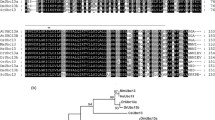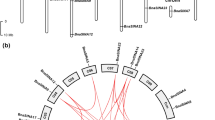Abstract
A novel endonuclease, a new member of the RAD2 nuclease family, has been identified from the higher plant, rice (Oryza sativa L. cv. Nipponbare), and designated as OsSEND-1. The open reading frame of the OsSEND-1 cDNA encoded a predicted product of 641 amino acid residues with a molecular weight of 69.9 kDa. The encoded protein showed a relatively high degree of sequence homology with the RAD2 nuclease family proteins, especially RAD2 nuclease, but it differed markedly from FEN-1, XPG or HEX1/EXO1. The N- and I-domains in the family were highly conserved in the OsSEND-1 sequence. The protein was much smaller than XPG, but larger than HEX1/EXO1 and FEN-1. The genome sequence was composed of 14 exons, and was localized at the almost terminal region of the short arm of chromosome 8. Northern blotting and in situ hybridization analyses demonstrated preferential expression of OsSEND-1 mRNA in proliferating tissues such as meristem. The mRNA level of OsSEND-1 was induced by UV and DNA-damaging agent such as MMS or H2O2, indicating that OsSEND-1 has some roles in the repair of many types of damaged DNA. The recombinant peptide showed endonuclease activity.
Similar content being viewed by others
References
Alleva, J.L. and Doetsch, P.W. 1998. Characterization of Schizosaccharomyces pombe Rad2 protein, a FEN-1 homolog. Nucleic Acids Res. 26: 3645–3650.
Baba, A., Hasegawa, S. and Syono, K. 1986. Cultivation of rice protoplasts and their transformation mediated by Agrobacterium spheroplasts, Plant Cell physiol. 27: 463–471.
Britt, A. B. 1999. Molecular genetics of DNA repair in higher plants. Trends Plant Sci. 4: 20–25.
Britt, A.B., Chen, J.J., Wykoff, D. and Mitchell, D. 1993. A UV-sensitive mutant of Arabidopsis defective in the repair of pyrimidine-pyrimidinone (6–4) dimmers. Science. 261: 1571–1574.
Calleja, F.M.G.R., Nivard, M.J.M. and Eeken, J.C.J. 2001. Induced mutagenic effects in the nucletide excision repair defi-cient Drosophila mutantmus201D1, expressing a truncated XPG protein. Mutat. Res. 461: 279–288.
Constantinou, A., Gunz, D., Evans, E., Lalle, P., Bates, P.A., Wood, R.D. and Clarkson S.G. 1999. Conserved residues of human XPG protein important for nuclease activity and function in nucleotide excision repair. J. Biol. Chem. 274: 5637–5648.
Culligan, K.M. and Hays, J.B. 1997. DNA mismatch repair in plants. Plant Physiol. 115: 833–839.
Davies, A.A, Friedberg, E.C., Tomkinson, A.E., Wood, R.D. and West, S.C. 1995. Role of the Rad1 and Rad10 proteins in nucleotide excision repair and recombination. J. Biol. Chem. 270: 24638–24641.
Evans, E., Fellows, J., Coffer, A. and Wood, R.D. 1997. Open complex formation around a lesion during nucleotide excision repair provides a structure for cleavage by human XPG protein. EMBO J. 16: 625–638.
Fidantsef, A.L., Mitchell, D.L. and Britt, A.B. 2000. The Arabidopsis UVH1 gene is a homolog of the yeast repair endonuclease RAD1. Plant Physiol. 124: 579–586.
Furukawa, T., Kimura, S., Ishibashi. T., Hashimoto, J. and Sakaguchi, K. 2001. A Plant homologue of 36 kDa subunit of replication factor C: molecular cloning and characterization. Plant Science. 161: 99–106.
Gallego, F., Fleck,O., Li, A., Wyrzykowska, J. and Tinland, B. 2000. AtRAD1, a plant homologue of human and yeast nucleotide excision repair endonuclease, is involved in dark repair of UV damages and recombination. Plant J. 21: 507–518.
Goff, S.A., Ricke, D., Lan, T.H., Presting, G., Wang, R., Dunn, M., Glazebrook, J., Sessions, A., Oeller, P., Varma, H., Hadley, D., Hutchison, D., Martin, C., Katagiri, F., Lange, B.M., Moughamer, T., Xia, Y., Budworth, P., Zhong, J., Miguel, T., Paszkowski, U., Zhang, S., Colbert, M., Sun, W.L., Chen, L., Cooper, B., Park, S., Wood, T.C., Mao, L., Quail, P., Wing, R., Dean, R., Yu, Y., Zharkikh, A., Shen, R., Sahasrabudhe, S., Thomas, A., Cannings, R., Gutin, A., Pruss, D., Reid, J., Tavtigian, S., Mitchell, J., Eldredge, G., Scholl, T., Miller, R.M., Bhatnagar, S., Adey, N., Rubano, T., Tusneem, N., Robinson, R., Feldhaus, J., Macalma, T., Oliphant, A. and Briggs, S. 2002. A draft sequence of the rice genome (Oryza sativa L. ssp. japonica). Science 296: 92–100.
Habraken, Y., Sung, P., Prakash, L. and Prakash, S. 1993. Yeast excision repair gene RAD2 encodes a single-stranded DNA endonuclease. Nature 366: 365–368.
Harushima, Y., Yano, M., Shomura, A., Sato, M., Shimano, T., Kuboki, Y., Yamamoto, T., Lin, S. Y., Antonio, B. A., Parco, A., Kajiya, H., Huang, N., Yamamoto, K., Nagamura., Y., Kurata, N., Khush G. S. and Sasaki, T. 1998. A high-density rice genetic linkage map with 2275 markers using a single F2 population. Genetics 148: 479–494.
Hiraoka, L.R., Harrington, J.J., Gerhard, D.S., Lieber, M.R. and Hsieh, C.L. 1995. Sequence of human FEN-1, a structure specific endonuclease, and chromosomal localization of the gene (FEN-1) in mouse and human. Genomics 25: 220–225.
Ishibashi, T., Kimura, S., Furukawa, T., Hatanaka, M., Hashimoto, J. and Sakaguchi, K. 2001. Two types of replication protein A 70 kDa subunit in rice, Oryza sativa: molecular cloning, characterization, and cellular and tissue distrubution. Gene 272: 335–343.
Kimura, S., Kai, M., Kobayashi, H., Suzuki, A., Morioka, H., Otsuka, E. and Sakaguchi, K. 1997. A structure-specific endonuclease from cauliflower (Brassica oleracea var. botrytis) inflorescence. Nucleic Acids Res. 25: 4970–4976.
Kimura, S., Ueda, T., Hatanaka, M., Takenouchi, M., Hashimoto, J. and Sakaguchi, K. 2000. Plant homologue of flap endonclease-1: molecular cloning, characterization, and evidence for expression in meristematic tissues. Plant Mol. Biol. 42: 415–427.
Kimura, S., Ishibashi, T., Hatanaka, M., Sakakibara, Y., Hashimoto, J. and Sakaguchi, K. 2000. Molecular cloning and characterization of a plant homologue of the origin recognition complex 1 (ORC1). Plant Sci. 158: 33–39.
Kimura, S., Suzuki, T., Yanagawa, Y., Yamamoto, T., Tanaka, I., Hashimoto, J. and Sakaguchi, K. 2001. Characterization of plant proliferating cell nuclear antigen (PCNA) and flap endonuclease-1 (FEN-1), and their distribution in mitotic and meiotic cell cycles. Plant J. 28: 643–653.
Kimura, S., Uchiyama, Y., Kasai, N., Namekawa, S., Saotome, A., Ueda, T., Ando, T., Ishibashi, T., Oshige, M., Furukawa, T., Yamamoto, T., Hashimoto, J. and Sakaguchi, K., 2002. A novel DNA polymerase homologous to E. Coli DNA polymerase I from higher plant, rice (Oryza sativa L.). Nucleic Acids Res. 30: 1585–1592.
Landry, L.G., Stapleton, A.E., Jim, J., Hoffman, P., Hays, J.B., Walbot, V. and Last, R.L. 1997. An Arabidopsis photolyase mutant is hypersensitive to ultraviolet-B radiation. Proc. Natl. Acad. Sci. 94: 328–332.
Lee, B-I. and Wilson, D.M. III. 1999. The RAD2 Domain of Human Exonuclease 1 exhibits 5′ to 3′ exonuclease and flap structure-specific endonuclease activities. J. Biol. Chem. 274: 37763–37769.
Lieber, M.R. 1997. The FEN-1 family of structure-specific nuclease in eukaryotic DNA replication, recombination and repair. Bioessays 19: 233–240.
Liu, Z., Hossain, G.S., Islas-Osuna, M.A., Mitchell, D.L. and Mount, D.W. 2000. Repair of UV damage in plants by nucleotide excision repair; Arabidopsis UVH1 DNA repair gene is a homolog of Saccharomyces cerevisiae Rad1. Plant J. 21: 519–528.
Liu, Z., Hall, J.D. and Mount, D.W. 2001. Arabidopsis UVH3 gene is a homologue of the Saccharomyces cerevisiae RAD2 and human XPG DNA repair genes. Plant J. 26: 329–338.
Murray, J.M., Tavassoli, M., Al-Harithy, R., Sheldrick, K.S., Lehmann, A.R., Carr, A.M. and Watts, F.Z. 1994. Structural and functional conservation of the human homolog of the Schizosaccharomyces pombe rad2 gene, which is required for chromosome segregation and recovery from DNA damage. Mol. Cell. Biol. 14: 4878–4888.
O'Donovan, A., Davies, A.A., Moggs, J.G., West, S.C. and Wood, R.D. 1994a. XPG endonuclease makes the 3′ incision in human DNA nucleotide excision repair. Nature 371: 432–435.
O'Donovan, A., Scherly, D., Clarkson, S.G. and Wood, R.D. 1994b. Isolation of active recombinant XPG protein, a human DNA repair endonuclease. J. Biol. Chem. 269: 15965–15968.
Reagan, M.S., Pittenger, C., Siede, W. and Friedberg, E.C. 1995. Characterization of a mutant strain of Saccharomyces cerevisiae with a deletion of the RAD27 gene, a structural homolog of the RAD2 nucleotide excision repair gene. J. Bact. 177: 364–371.
Sato, Y., Hong, S-K., Tagiri, A., Kitano, H., Yamamoto, N., Nagato, Y., and Matsuoka, M. 1996. A rice homeobox gene, OSH1, is expressed before again before organ differentiation in a specific region during early embryogenesis. Proc. Natl. Acad. Sci. USA 93: 8117–8122.
Sekelsky, J.J., Hollis, K.J., Eimerl, A.I., Burtis, K.C. and Hawley, R.S. 2000. Nucleotide excision repair endonuclease genes in Drosophila melanogaster. Mutat. Res. 459: 219–228.
Stapleton, A.E. and Walvot, V. 1994. Flavonoids protect maize DNA from the induction of ultraviolet radiation damage. Plant Physiol. 105: 881–889.
Stapleton, A.E., Thornber, C.S. and Walbot, V. 1997. UV-B component of sunlight causes measurable damage in field grown maize (Zea mays L.): developmental and cellular heterogeneity of damage and repair. Plant Cell Envir. 20: 279–290.
Stucki, M., Jonsson, Z.O. and Hubscher, U. 2001. In eukaryotic flap endonuclease 1, the C terminus is essential for substrate binding. J. Biol. Chem. 276: 7843–7849.
Suzuka, I., Hata, S., Matsuoka, M., Kosugi, S. and Hashimoto, J. 1991. Highly conserved structure of proliferating cell nuclear antigen (DNA polymerase auxiliary protein) gene in plants. Eur. J. Biochem. 195: 571–575.
Vogel, E.W. and Nivard, M.J.M. 2001. Phenotypes of Drosophila homologs of human XPF and XPG to chemicalloy-induces DNA modifications. Mutat. Res. 476: 149–165.
Wilson, D.M.çV., Carney, J.P., Coleman, M.A., Adamson, A.W., Christensen, M. and Lamerdin, J.E. 1998. Hex1:a new human Rad2 nuclease family member with homology to yeast exonuclease1. Nucleic Acids Res. 26. 3762–3768.
Author information
Authors and Affiliations
Corresponding author
Rights and permissions
About this article
Cite this article
Furukawa, T., Kimura, S., Ishibashi, T. et al. OsSEND-1: a new RAD2 nuclease family member in higher plants. Plant Mol Biol 51, 59–70 (2003). https://doi.org/10.1023/A:1020789314722
Issue Date:
DOI: https://doi.org/10.1023/A:1020789314722




